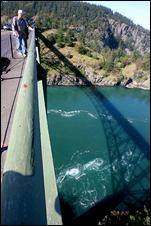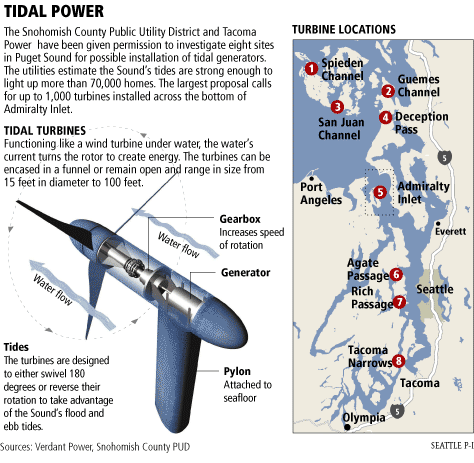forum
library
tutorial
contact

Utilities to Explore Power in the Tides
by Colin McDonaldSeattle Post-Intelligencer, May 9, 2007
|
the film forum library tutorial contact |

|
Utilities to Explore Power in the Tidesby Colin McDonaldSeattle Post-Intelligencer, May 9, 2007 |
 When the tide changes at Deception Pass, the black water erupts into a frothy mess, with whirlpools big enough to swallow kayaks.
When the tide changes at Deception Pass, the black water erupts into a frothy mess, with whirlpools big enough to swallow kayaks.
Pulled by the sun and moon, the water surges through the narrow gap four times a day -- smashing logs against the rock walls and providing an exchange of water critical to the health of the ecosystem.
The Snohomish County Public Utility District has been given the authority to figure out how to turn that tidal power into electricity.
The Federal Energy Regulatory Commission issued three-year permits to the PUD and Tacoma Power to investigate eight sites in the Sound for possible installation of tidal generators. Precise mapping of tidal movements using underwater sonar will begin this summer.
If approved and installed, the turbines would harness tidal flow the same way wind farms tap a steady breeze. The utilities estimate the Sound's tides are strong enough to light up more than 70,000 homes. The largest installation calls for up to 1,000 turbines churning along the bottom of Admiralty Inlet.
The local projects are some of the most ambitious in the country, and follow on the heels of the world's first free-flowing tidal projects, now being installed and tested off the coasts of Scotland and Ireland.
"Puget Sound is a jewel," said Trey Taylor, president of Verdant Power, which last week completed the first tidal-power installation connected to the grid in the United States.
Taylor's company has six generators in the East River in New York and is looking to expand here. With 14-foot tides and a political climate supportive of expanding "green" energy sources, Taylor said the Sound is one of the best locations in the country for capturing water power.
 The electricity would be emission-free and, unlike solar and wind energy, steady enough of a power source to be counted on for centuries.
The electricity would be emission-free and, unlike solar and wind energy, steady enough of a power source to be counted on for centuries.
"'Zero' is a real magic number when it comes to carbon emissions," said U.S. Rep. Jay Inslee, D-Bainbridge Island.
Inslee has introduced a bill with seven co-sponsors that would streamline the FERC approval process for energy projects and provide $50 million a year for tidal and wave energy research.
While waves on the Pacific Ocean have more power potential than estuary tides, the technology to transform ocean swells to electricity is in its infancy and the waves are far from the transmission lines needed to bring the juice to cities.
Inslee readily admits underwater construction in critical salmon habitat, where sea mammals lurk and fishermen like to drop their nets and lines, isn't an easy sell.
"But my view is that global warming is such an existential threat that we have to look at new technology," he said. "It is not like this is your Cuisinart going around."
Because water is 800 times more dense than air, the blades of the underwater turbines don't need to be as long or spin as fast as their windmill counterparts, said Glen Darou, president of Clean Current Power Systems.
The hope is that the relatively lethargic nature of the turbines, turning at less than 30 revolutions per minute, will minimize the impact the blades will have on sea life.
This month, Darou's company will pull up a prototype turbine it installed near Race Rocks on the southern tip of Vancouver Island.
A little more than 16 feet wide, the prototype looks like a cross between a cement truck and the engine off the wing of a Boeing jetliner. It sits on top of metal pilings drilled into the bedrock in 70 feet of water and since December has provided enough electricity to replace the diesel generators that heat and light the living quarters of the Race Rocks Lighthouse.
Clean Current's commercial version would be almost 100 feet across and large enough for a sea lion to swim through, Darou said.
"We are happy with everything but the bearings," Darou said of the turbine's performance.
Initial results have shown fish and sea mammals tend to swim around the turbine. His company is conducting further studies to see how organisms such as jellyfish, which simply move with the current, are affected by the blades.
Darou said the commercial version of its turbine would spin at 10 rpm, but at its size, the tips would be moving through the water at 40 knots. There are no conclusive studies on the effect something that large might have on sea life.
There also are concerns that the installation of water turbines will close parts of the Sound to fishing and diving.
"You can't really drift a gillnet into one of those, or drop a crab pot nearby," said Daryl Williams, the Tulalip Tribes' environmental liaison. "There is a lot to be learned, and most of the studies have been started in other countries -- and most of those just started in the last few months."
Researchers at the University of Washington are looking at what the cumulative effects on the Sound would be if the tides were tapped for power.
"If you put some turbines in the water and those turbines are extracting power from that water, how much power can you extract before you have an impact on Puget Sound?" said mechanical engineer Philip Malte, who is heading the study.
If enough power is taken out, the high tides would be lower and the low tides would be higher, Malte said. Even a change of less than a foot would drastically alter the beaches and the life that depends on them.
Using mathematical models, Malte and his team are working to predict how much power can be taken out of the Sound without changing the tides.
Across the industry the assumption is that taking 15 percent of the available power would have no discernable effect. But the industry is less than a decade old -- and there is little track record to go by.
"You can study it and study it," Malte said, "but at some point we are going to have to put a turbine in the water to find out if this will work."
learn more on topics covered in the film
see the video
read the script
learn the songs
discussion forum
